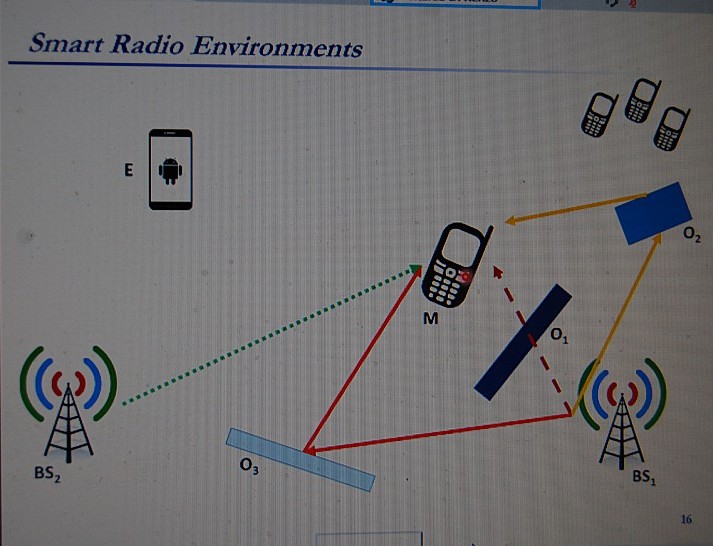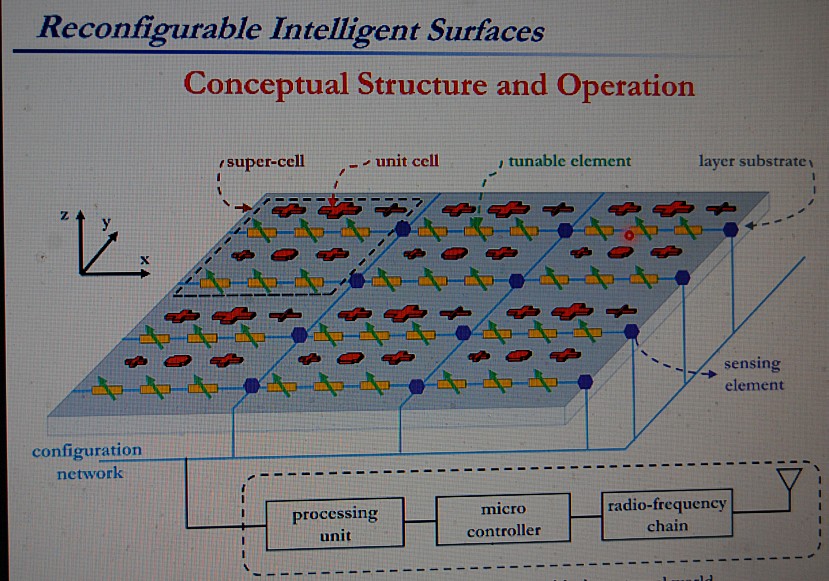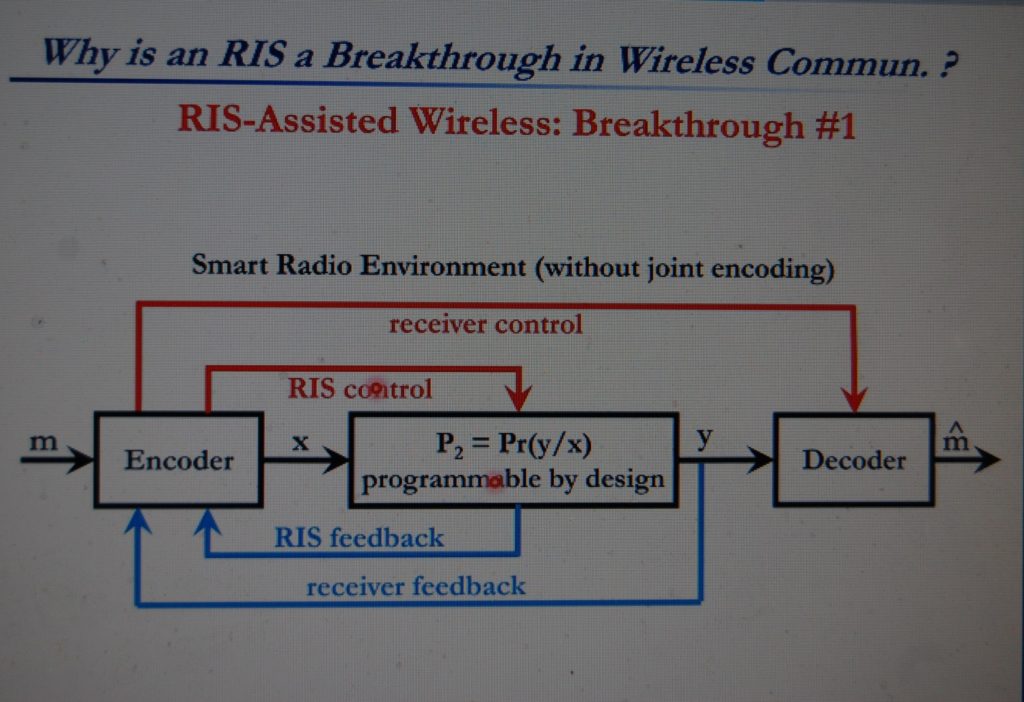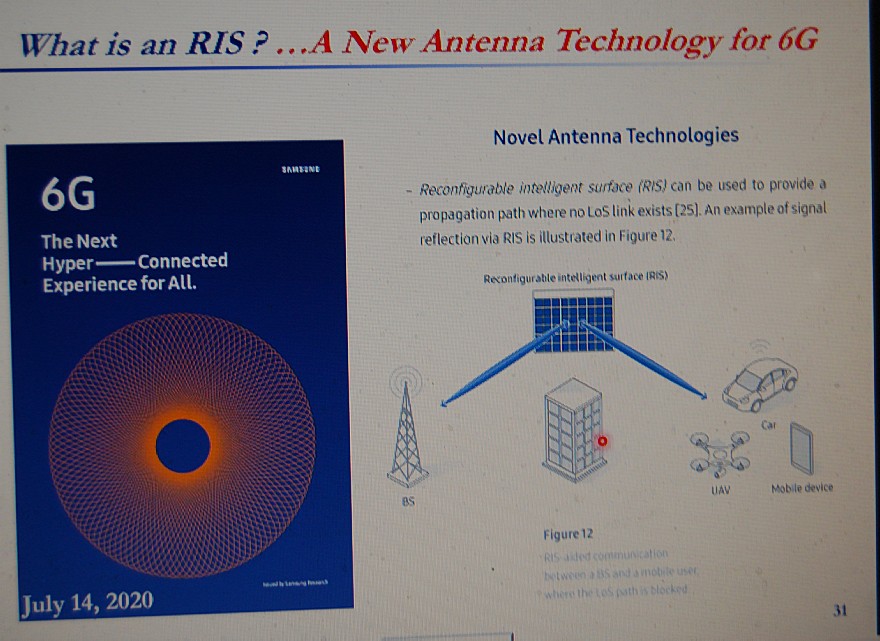IEEE COMSOC VIRTUAL MEETING–102820–RECONFIGURABLE INTELLIGENT SURFACES
| January 5, 2021 | Posted by Frank Gomez under COMSOC, General |
Comments off
|
REPORT 0N 10/28/2020 COMSOC VIRTUAL BRIEFING
“Smart Radio Empowered by Reconfigurable Intelligent Surfaces”
Presenter : IEEE COMSOC Distinguished Lecturer: Marco Di Renzo
CNRS Research Director (CNRS Professor), CentraleSupelec, Paris-Saclay University, Paris, France
The program of Professor M C Di Renzo at the University of Paris / Saclay is directed to investigate an emerging transmission technology for application to particular future wireless needs. The program considers that the wireless system 5g, 6G and beyond, will be an integrated platform for communications, sensing and computing functions.
The specific problem areas that the speaker identifies are: (1) lack of control over the wireless environment (propagation; atmospheric attenuation, interference due to other physical objects in the field of view, etc.); and (2) more power is needed whenever additional signals are transmitted to deal with the performance degradation in (1).
The solution proposed was to consider almost passive (EM) electromagnetic tuned surfaces that could be used to repoint the 5G transmitted signal (from a base station to a mobile devise -user equipment). This reflection system would have to implement some very involved functions (algorithms) to reorient the signal to the intended user. In this concept work, only a general restriction in minimizing the power required was notionally stated. This type of surface was described as a “Reconfigurable Intelligent Surface” (RIS). RIS is considered an “emerging concept for smart radio environments”
The intent of this RIS program can be described in the pictorial shown in Figure 1. A set of Base Stations (BS) may be transmitting their signal intended to the particular user equipment (UE). However, the UE may not be in the main beam of the BS. Hence its received signal is severely diminished, being in the sidelobe. This will result in much lesser synchronization probability of the signal, plus increased bit error. For the Smart phone, a properly placed RIS would capture the signal from the BS, and re-route It to the properly selected UE. This RIS would (potentially, but not necessarily) also compensate for the loss of signal due to attenuation (environmental, physical intervening buildings and structures, multipath bounce off the ground that introduced multiphase clutter at the UE input antenna port). If the RIS system were able to do these tasks, it could become an integral part of the wireless network.

Figure 1 shows a notion of a “Smart Radio Environment”—-with an active RIS to steer the signal to the UE.
To carry this concept a step further, RIS is proposing more than a simple reflection from a smooth homogeneous metallic sheet, RIS would do more than a straight forward Snell’s law(angle of reflection equals angle of incidence for a metallic surface with no absorption of energy from the wave). It fact, it would have to implement a modified Snell’s Law. It would be receiving a beam from the BS, and accurately routing it the precise direction of the UE. Again, RIS depends on adding a minimal (TBD) power requirement to the wireless network. A concept of the basic unit set for an RIS is shown in Figure 2.

Figure 2.Concept of the basic cell for a RIS.
Several initial models of the RIS units have been constructed at MIT. UC Sab Diego. and Aanlt University in Sweden, as described by Professor Di Renzo. However, no experimental data was presented on their performance. No testing plans that would include any model scenarios were presented. The speaker said that no such data is available. It must be noted that Professor Di Renzo’s group concentrates on analyses and physical modeling. It contracts with experimental groups to do actual testing. One chart presented showed a test of an RIS surface in some anechoic chamber in a non-specified lab in China. The remainder of the talk covered the extensive work of Professor Di Renzo’s analyses group. One notional effort examined the mutual coupling results for an array of spaced reflecting elements, Another looked at the bit transmission rates (bits per second per Hz) and bit error rates. Another considered reliability. A general notion of what each block of the RIS unit would be is shown in Figure 2. Discussion of the actual shifting reflective array elements that would be proposed (say SOI with PIN diodes, or a MEMS unit with capacitive coupling, etc for example) would be a topic that all COMSOC antenna engineers would be interested in hearing.
An area of future analyses is shown in Figure 3. Note that minimal power would be used for control and pointing re RIS array’s pointing. Minimal Digital Signal Processing is proposed. The title of the Figure 3 gives their goal as RIS Assisted Wireless.

Figure 3. shows a notional control block diagram for RIS system. It will be a challenge to implement such a system with the implied (and extensive proposed tracking, identifying, and correcting the coded modulation) signal processing.
Note that two complex feedback loops are conceptually proposed. One is listed as “RIS Feedback”, which presumably provides data from the RIS back to the BS (“encoder”). The other is listed as “receiver feedback”, which presumably means providing data from the UE receiver back to the BS via the RIS.
Certainly, many interesting concepts were proposed by Professor Di Renzo in this talk. We will be looking forward to future presentations of actual test data for his RIS concepts. Then we could begin to examine how this would potentially fit within the current 5G specifications and 5G standardizations. We are probably looking at 6G for such an enhanced system. See Figure 4 for a chart from Samsung alluding to a similar technology.

Figure 4. Note that SAMSUNG is also looking forward to this RIS technology for 6G.
We thank Professor Di Renzo for a most interesting IEEE COMSOC presentation. Fortunately we on the West Coast USA were able to attend the VIRTUAL meeting at a convenient time for Professor Di Renzo in Paris, 9 time zones ahead of us. Thanks to the IEEE COMSOC Distinguished Lecturer program organizers for making this presentation possible. &&&&&&&&&&&&&&&&&&&&&&&&&&&&&&&&&&&&&&&&&&&&&&&&&&&&&&&&&&&&&&